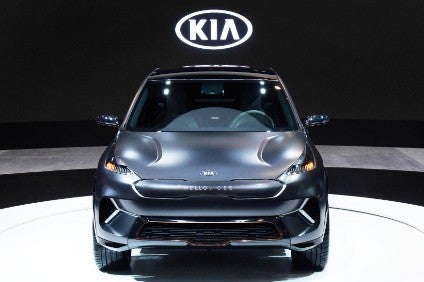
Kia said its new ‘Boundless for all’ future mobility vision, presented at the 2018 CES here in Las Vegas, will bring “a future in which opportunities for mobility and transportation are endless”.
The Hyundai Motor Group affiliate is also demonstrating new technologies as part of its new ACE strategy to make its cars more Autonomous, Connected and Eco/Electric.
The future mobility vision “is Kia’s manifesto for its role as a mass mobility provider in the future”, according to vice chairman and R&D Centre chief Woong-chul Yang.
“Consumers are bound today by the idea a car is ‘just a vehicle’ but Kia is committed to providing a broader solution to mobility.
“Boundless for all represents a future in which a vehicle can be so much more than the sum of its parts.
The ACE strategy is based around three core elements:

US Tariffs are shifting - will you react or anticipate?
Don’t let policy changes catch you off guard. Stay proactive with real-time data and expert analysis.
By GlobalData- Autonomous: Kia plans to commercialise Level 4 autonomous driving with ‘smart city’ testing due to start in 2021
- Connected: By 2025, the automaker will adopt connected car technologies across all its vehicle segments with the aim every model will be connected by 2030
- Eco/Electric: Kia will launch 16 new advanced powertrain vehicles by 2025 – including new hybrids, PHEVs and Evs plus a new fuel cell EV in 2020.
As reported separately, it plans to extend its WiBLE car sharing service beyond Korea, starting with Europe, in 2018.
Kia exhibits at CES show how vehicles could be optimised for enhanced connectivity as they become more autonomous. Visitors can interact with developing autonomous drive technology through a virtual reality simulator while also experiencing a V2X diorama demonstrating how vehicles could communicate with other vehicles and their surroundings.
“Virtual reality, self driving cars and ‘vehicle to everything’ connectivity were all once considered technologies of the future. As they rapidly become a reality, Kia is exploring how to deploy these new technologies for its customers,” said Yang.
16 new electrified vehicles by 2025
Kia plans to offer 16 electrified vehicles by 2025, including a fuel-cell electric vehicle (FCEV) in 2020.
“By 2025, we will [have] five new hybrids and plug-in hybrids, five new battery EVs, and an all-new mass market FCEV,” said Yang.
It is exhibiting the Niro EV Concept at CES 2018. Designed in Korea, the EV Concept is a full electric compact SUV.
The traditional grille – no longer required for engine cooling – is replaced by a smooth interactive display panel, combined with slim lamp technology in the overall front. In profile, the concept draws inspiration from the current Niro.
Anticipating such a car would be driven most frequently on urban and suburban roads, the concept has new technologies to enhance safety for pedestrians.
New Active Pedestrian Warning System (APWS) features a combination of front view cameras, object recognition technology and front speakers. If the system detects a pedestrian or cyclist crossing in front of the car, the speakers sound an alert targeted specifically at that person, warning them of the car’s presence. APWS is matched by a new interactive lighting system, which offers users and pedestrians a highly-intuitive visual communication with the vehicle.
The concept is powered by a next-generation electric vehicle powertrain, using new production technologies earmarked for near-future EVs. Energy is provided by a high-capacity 64 kWh lithium-polymer battery pack, paired with a 150kW electric motor. The concept suggests a production driving range of 238 miles (383km) with zero tailpipe emissions.
Othe CES exhibits include the latest HMI technologies, autonomous drive features and claimed world first in-car 5G connection.
The Niro EV Concept’s pioneering new HMI has infotainment and HVAC controlled by touch and gesture, with the steering wheel acting as a remote. The driver can swipe along a perforated leather area on the base of the two-spoke wheel, with different gestures serving to switch between favourite music tracks, turn up the volume, and adjust cabin ventilation settings. A digital dashboard display provides additional information to the driver, such as vehicle settings, powertrain status, and trip information.
The HMI allows drivers to log-in to the vehicle using face and voice recognition, developed in collaboration with Amazon Web Services (AWS), which welcomes drivers and adjusts vehicle settings based on preset individual preferences. Leveraging Amazon Rekognition and Amazon Polly – highly accurate facial analysis and voice services – the new system disables many of the car’s functions if the driver does not pass the identification process.
The concept’s Separate Sound Control System, allowing users in the front and rear rows to experience sound separation technology which allows front and rear passengers to listen to their own music at the same time without intruding on others in the car. The system features eight speakers installed in the headrests, simultaneously pumping out sounds for each seat row, and using noise-cancellation technology to mute sound from the other row of seats. By creating two sound zones in the car, occupants in different rows can enjoy listening to separate music or podcasts. Developed in-house, Kia believes this technology could be adapted to enhance occupant comfort in future production cars.



